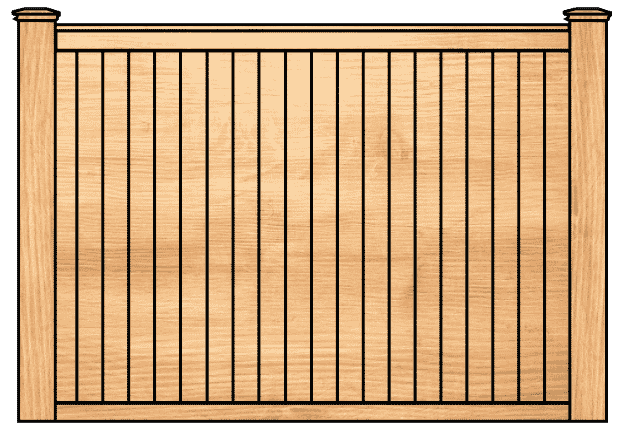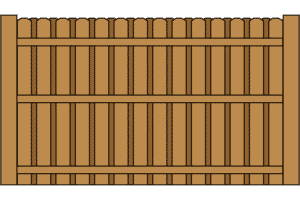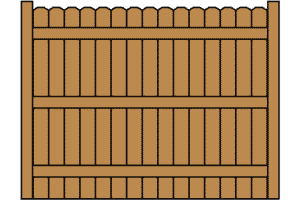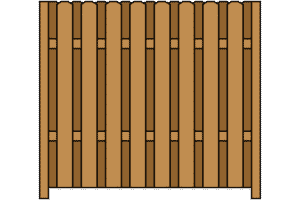Pine Fence Installation
Pine Fencing
A Great Wood Privacy Fence Option
Pine (or pressure-treated pine) is made from pine trees for a durable, long-lasting performance. This material offers can have many different top cuts and heights including the classic dog-ear pattern. By nature, treated pine will have splits and cracks in it. Treated pine does not have loose knots or knot holes. However, treated pine is more prone to shrinkage and warpage compared to cedar.
Pine can be painted or stained to match your exterior decor and extend the fence life. The pine pickets are pressure-treated to protect against rot and decay using MCA (Micronized Copper Azole) which is EPA-approved, safe for environment, and pets. Pine typically costs less than other fence building materials and is a popular choice for it’s affordability.

Pine Fence Benefits
Fence Guys Fence Performance & Advantages
At Fence Guys we understand that every project is different. This is why we offer a wide range of fencing options – each with their own advantages.
There are a variety of wood fence installation and style options available. The benefits of each pine fence style can vary. However, the benefits here demonstrate an overall performance of our top performing pine fence style with premium options.
Privacy rating demonstrates the maximum privacy level you would get from your fence.
Fence Strength rating demonstrates the maximum durability level you would get from your fence.
Average Fence Lifespan rating demonstrates the maximum lifespan you would get from your fence.
This rating measures the average cost to build a fence with this material type.
Pine Fence Features
Fencing Northwest Arkansas With Excellence
At Fence Guys, we build every fence to ASTM Standards (or higher). Our level of craftsmanship is never compromised. Our reputation depends on it and we’re proud to put our name on every fence we build.
Your pine fence project can be as unique as your home and should add functionality, security, and curb appeal. Hover over these pine fence features to learn about some of the Features available for your fence project.
CLICK A FENCE FEATURE TO LEARN MORE
Instant Pricing
Get A Fence Price Online Right Now!
Did you know that you can get an INSTANT PRICE on your fence without leaving your couch? That’s right! No measuring. No walking the perimeter. No sweat!
Our Pricing Tool lets you draw your fence on a map of your property, add your gates, and select your fence options. You will get an instant estimate without even picking up the phone.
Pine Fence Styles
Uniquely Styled Fences For Every Yard
Ready to pick our your fence style? We build fences in many configurations so you can find the perfect wood fence for your backyard. But if you don’t see it here, ask us about our custom fence options where we bring your ideas from concept to completion.
Frequently Asked Questions About Pine Fence Installation
Pine fences are a popular choice for homeowners due to their affordability and durability. Pressure-treated pine is specifically designed to resist rot and decay, making it a long-lasting option for outdoor fencing. Pine is also versatile, allowing for various top cuts and heights, including the classic dog-ear pattern. Additionally, it can be painted or stained to match your home’s exterior decor, providing both functionality and aesthetic appeal.
The lifespan of a pine fence can vary depending on the level of maintenance and environmental conditions, but on average, a well-maintained pine fence can last between 10 and 15 years. Regular upkeep, such as applying a protective stain, can help prevent damage from moisture and UV rays, further extending the life of your fence.
Yes, pine fences do require regular maintenance to keep them looking good and to prolong their lifespan. This typically includes staining or painting every few years to protect the wood from weathering and to prevent the growth of mold or mildew. Maintenance also involves checking for and repairing any splits or cracks that may develop over time due to the natural expansion and contraction of the wood.
Pine is more prone to warping and shrinkage compared to other types of wood, such as cedar. This is due to its natural tendency to absorb moisture, which can cause the wood to expand and contract. However, pressure-treated pine is less likely to warp if it is properly installed and maintained. Regular sealing can help minimize these issues and keep the fence stable.
Yes, one of the benefits of pine fencing is that it can be stained in a variety of colors to match your home or landscape. Staining not only enhances the appearance of the fence but also adds an extra layer of protection against the elements, helping to extend its life and maintain its structural integrity.
While pine fences are more affordable than cedar, they are also more susceptible to warping, shrinkage, and cracking. Cedar fences, on the other hand, have natural oils that make them more resistant to decay and insects. However, with regular maintenance, a pine fence can still be a durable and attractive option.
Pine fencing is generally less expensive than other wood options like cedar. The cost will depend on the size of the area being fenced, the height of the fence, and any additional features, such as decorative top cuts. While the initial cost is lower, it’s important to factor in the long-term maintenance costs.
Yes, pressure-treated pine is designed to resist insects and rot. The treatment process infuses the wood with preservatives that help protect it from termite damage and fungal decay, making it a durable choice for outdoor use.
Pine fences offer a variety of customization options, including different top cuts, heights, and gate designs. You can also choose to paint or stain the fence in a color that complements your property. Additionally, pine fences can be designed with added features like lattice tops or decorative posts to enhance their visual appeal.
Pressure-treated pine is treated with MCA (Micronized Copper Azole), which is an EPA-approved preservative. This treatment makes pine fences safe for the environment, pets, and plants. Additionally, pine is a renewable resource, and its use in fencing helps promote sustainable forestry practices.




